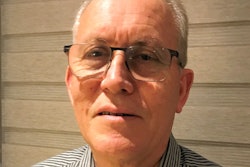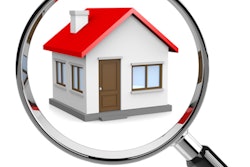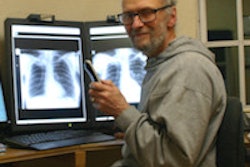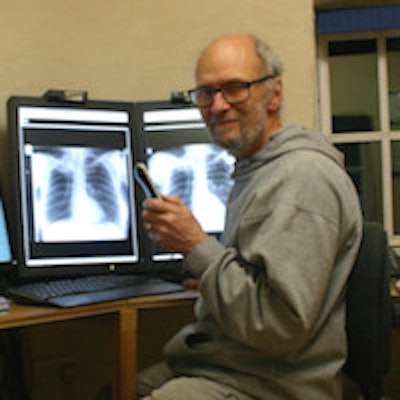
When he retired in 2010 from his position as consultant radiologist at the Northern Lincolnshire and Goole National Health Service (NHS) Trust in the U.K., Dr. Richard Harries had no intention of putting his feet up. Home-based part-time work would allow the best of both worlds, maintaining involvement in the profession he loved, while freeing him up for other pursuits such as voluntary work and a self-build project. To this end, he successfully piloted a new project at his hospital, now in its fifth year, and is on the lookout for other like-minded specialists to join him.
Harries' entire working career has been involved in technology, so the idea of pioneering a scheme to enable home-based practice did not daunt him. On the contrary, his NHS contract to provide around 20 hours of home reporting and one day a week as a consultant at Diana, Princess of Wales Hospital in Grimsby, 20 miles (32 km) from his home, has helped to ease the backlog of reports and improve radiology services for patients.
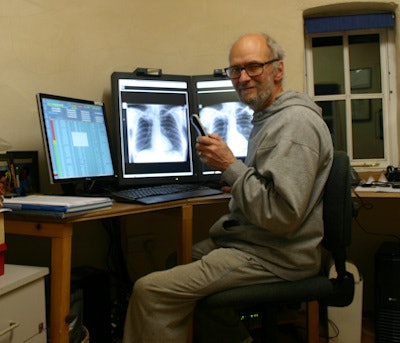 Flexible home-working can reduce reporting delays caused by a shortage of imaging specialists, Dr. Richard Harries said.
Flexible home-working can reduce reporting delays caused by a shortage of imaging specialists, Dr. Richard Harries said."There is a shortage of radiologists in the U.K. so the hospital was happy to allow this flexible way of working. There was no real time frame when the pilot began but so far it has worked well and I am hoping we can expand it to include other radiologists," Harries said.
The NHS provided hardware and IT support as part of the home-reporting contractual agreement, a tailor-made document to cover Harries' rights and responsibilities. In return, he reads and reports on between 25,000 and 35,000 images a year, mainly plain film, including accident and emergency, in-patient, and out-patient exams. Because the local hospitals are increasingly moving toward electronic patient records (EPRs), the radiology reports are then made available almost immediately to all parties.
Home office setup
His standard reporting setup includes a PC that operates on Windows 7 and three monitors (one nonimage monitor to handle patient data and two high quality 3 megapixel portrait monitors in black and white).
"I'm using the same RIS (developed by Soliton IT) as the NHS Trust, which means that the full patient radiology history and images are available when required. It's basically like I'm sitting at a workstation in the radiology department with access to all the other systems I routinely use, like email and pathology EPR. Plus my system is fully integrated in the voice recognition system. All these factors make this pilot for home-reporting hugely advantageous compared to remote reporting via third party companies," Harries noted.
For private use, he uses his own PC, while all hospital work is carried out on the hospital PC, which uses a virtual private network protected by SOPHOS encryption software. Harries pays for his own broadband, which serves both his personal and hospital PCs.
Broadband speed is a critical issue. He first used a leading provider's business broadband with a speed of 7-8 MB/second. While images to report could be received at a satisfactory speed, downloading historical images from previous studies took several minutes, and this proved too slow. Harries upgraded to a superfast fiber optic broadband, which has the download speed for home reporting of 38-40 MB/second recommended by the Royal College of Radiologists (RCR) and is suitable for timely downloads of historic image files. However, his usual practice is to download batches of around 100 to 120 exams overnight so they are ready for him to read the next day.
"In the department, download speeds are at least 100 MB/second, but the lower speed of home broadband means that I have to download and cache images overnight. Then using the DICOM viewer, I can call up images from the cache as I need them. The hospital's Agfa PACS wasn't suitable for working with cached images at the time we started this project, so I use eFilm as my DICOM viewer which is also fully integrated into the RIS."
Technical issues occasionally hamper the smooth functioning of his daily three-hour work stint. If downloads fail overnight, Harries calls the IT department or the RIS provider, depending on the problem, and the situation is usually resolved within a couple of hours.
"What we've set up here is entirely new, so it's bound to experience teething problems every once in a while," he noted.
Quality checks and appraisals
He self-checks for broadband speed using the provider's own online speed monitoring service. The supplier of the high-definition monitors also offers a package for self-checking quality and brightness of screens, but not all radiologists would be capable of carrying out these technical checks and the question of quality assurance would need to be addressed should the pilot be rolled out to radiologists further afield, according to Harries. He envisages that IT departments might be able to remotely access home-based PCs to resolve issues and if that should fail, a traditional courier service would have to be in place for rapid repair of broken equipment.
While Harries undergoes appraisals and revalidation and attends continuous professional development courses in the same way any full-time hospital-based doctor would, one area that would require fine tuning if the pilot grew would be discrepancy evaluation and peer review management.
"Discussion about discrepancies remains informal, and mainly conducted through RIS messaging. But this still generates effective and regular exchange," he said. "Across a larger home-reporting network, this system of informal messaging might need adjustment, and regular peer review for home reporters would also need to be addressed."
Currently, he is the only radiologist in the area to do home-reporting on this system, but Harries believes that to avoid reporting delays, the initiative would work better with one or two more home-based radiologists. This would allow for "hot reporting," and may reduce diagnostic mistakes in in-patients whose images are often interpreted by ward doctors rather than imaging specialists, possibly resulting in the wrong treatment. He pointed to pulmonary edema being too often misdiagnosed as an infection when nonradiologists initially interpret scans.
Despite the advantages of flexible working, Harries has met with resistance when trying to extend the project.
"It is ideal for retired or semiretired doctors, and for those with young children who want to work part-time," he noted. "What is less clear is [its suitability] for those who want to work full-time and make up some extra hours at home. Because the kit and IT support cost around 12,000 pounds (16,700 euros) as a one-off investment, they would have to do at least 20 hours of home-reporting a week for a group to justify the expense, and that is a lot of hours on top of a full-time hospital job."




